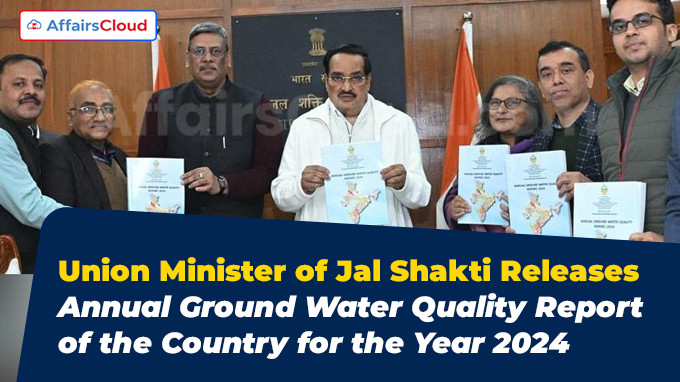 In December 2024, Union Minister Chandrakant Raghunath Patil, Ministry of Jal Shakti (MoJS) has released the Dynamic Ground Water Resource Assessment Report for the whole country for the year 2024.The assessment was conducted by Central Ground Water Board (CGWB) in partnership with States and UTs, which can be used for taking necessary interventions by various stakeholders.
In December 2024, Union Minister Chandrakant Raghunath Patil, Ministry of Jal Shakti (MoJS) has released the Dynamic Ground Water Resource Assessment Report for the whole country for the year 2024.The assessment was conducted by Central Ground Water Board (CGWB) in partnership with States and UTs, which can be used for taking necessary interventions by various stakeholders.
- As per the report, total annual groundwater recharge in India is 446.90 Billion Cubic Meter (BCM).
- The annual extractable ground water resource and annual groundwater extraction for all uses have been assessed as 406.19 BCM and 245.64 BCM, respectively.
- The average stage of groundwater extraction for the country stands at 60.47 %.
About Assessment Report:
i.Out of the total 6,746 assessment units including blocks, mandals and talukas, in the country, 4,951 (7.34%) assessment units are classified as ‘Safe’.
- 711 (10.5%), 206 (3.05%), 751 (11.1%) assessment units have been classified as ‘semi-critical’, ‘critical’ and ‘over-exploited’, respectively.
- Other than these units, there are 127 (1.8%) assessment units, which have been classified as ‘Saline’.
ii.The report showed that increase in groundwater recharge is mainly due to increase in recharge from water bodies/tanks and water conservation structures.
iii.Further, analysis of the report shows improvement in ground water conditions in 128 assessment units in India when compared with 2023 assessment data.
- The report observed the overall decline in percentage of over-exploited, critical and semi-critical units.
Key Findings:
i.As per the report, total annual Ground Water (GW) recharge has increased (15 BCM) significantly and extraction has decreased (3 BCM) in 2024 compared to 2017 assessment.
ii.Recharge from tanks, ponds, has increased from 13.98 BCM (in 2017 ) to 23.4 BCM (in 2024).
iii.The report showed that the percentage of assessment units under ‘Safe’ category have increased from 62.6% (in 2017) to 73.4% (in 2024).
- While, the percentage of Over-Exploited (OE) assessment units have decreased from 17.24% (in 2017) to 11.13% (in 2024).
MoJS Released Annual Ground Water Quality Report of the Country for the Year 2024
In December 2024, Union Minister CR Patil, Ministry of Jal Shakti (MoJS) has released the Annual Ground Water Quality Report for the whole country for the year 2024. This is for the 1st time that a report has adopted a Standard Operating Procedure (SOP) for groundwater quality monitoring, ensuring uniformity in data collection, examination and interpretation.
- The groundwater assessment was conducted by CGWB, which can be used for taking suitable remedial measures and further framing of policies by various stake-holders.
About the Report:
i.This report offers comprehensive analysis of groundwater quality of the country through background monitoring, trend analysis and hotspot identification.
ii.The report has covered a total of 15,259 groundwater monitoring locations to assess groundwater quality.
Key Findings:
i.The report highlighted significant concerns like: the high concentration of nitrate, fluoride, arsenic, and iron in groundwater. The report found that nearly 20% of the samples exceeded the permissible limit for nitrate, followed by fluoride (9.04%) and arsenic (3.55%).
ii.The report showed that Calcium (Ca) is most prevalent cation, followed by Sodium (Na) and Potassium (K) while, bicarbonate (HCO3)dominates the anion content, followed by Chloride (Cl) and Sulphate (SO4).
- This shows that India’s overall water is of Calcium-Bicarbonate type.
iii.The report observed that groundwater quality varies significantly across the country, 100% of the water samples for certain states like: Arunachal Pradesh (AR), Mizoram, Meghalaya, and Jammu & Kashmir (J&K) met the Bureau of Indian Standards (BIS) standards.
- While, states like Rajasthan, Haryana, and Andhra Pradesh (AP) witnessed widespread contamination.
iv.The report noted that monsoon season showed some improvement in water quality, specifically in areas affected by High Electrical Conductivity (HEC) and Fluoride.
States Facing Challenges from Specific Contaminants:
i.Nitrate Contamination: As per the report, Rajasthan, Tamil Nadu (TN), and Maharashtra have reported the highest incidences of nitrate contamination, with more than 40% water samples exceeded the permissible limit. This is mainly due to agricultural runoff and overuse of fertilizers.
ii.Fluoride Contamination: States like: Rajasthan, Haryana, Karnataka, AP and Telangana have reported the highest incidences of fluoride contamination.
iii.Arsenic Contamination: As per the report, several states particularly in the floodplains of the Ganga and Brahamputra rivers such as West Bengal (WB), Jharkhand, Bihar, Uttar Pradesh (UP), Assam and Manipur, as well as areas in the Punjab and Rajnandgaon district in Chhattisgarh have reported the elevated arsenic (As) level i.e. more than 10 ppb.
iv.Uranium Contamination: The report showed that 42% water samples from Rajasthan with Uranium (Ur) concentration exceeded 100 ppb, followed by Punjab (30%).
- Also, groundwater samples from states like: Rajasthan, Gujarat, Haryana, Punjab, TN, AP and Karnataka identified as over-exploited, critical and semi-critical groundwater stress zones, were found with Ur concentrations more than 30 ppb.
v.States which are most severely affected by high EC value in groundwater: Rajasthan, Delhi, Gujarat, Haryana, Punjab, Telangana, AP and Karnataka.
Key Findings Related to Irrigation Suitability:
i.The report also provides a comprehensive assessment of groundwater quality in India for Irrigation Suitability. It has examined Sodium Adsorption Ratio (SAR) and Residual Sodium Carbonate (RSC) values, are two main indicators of water suitability for irrigation.
ii.As per SAR classification, 100% of the water samples from North-East (NE) states like: Assam, AR, Meghalaya, Nagaland, Tripura are in the excellent category for irrigation, which means the groundwater in these states is highly suitable for irrigation.
- Some of the other states and Union Territories (UTs) that fall in the excellent category for irrigation: Andaman and Nicobar Islands, Chandigarh, Puducherry, Himachal Pradesh (HP), and Kerala.
iii.States which fall in Very High Sodium range and are unsuitable for irrigation purposes: AP (0.96%), Gujarat (1.27%), Haryana (0.34%), Punjab (0.76%), Rajasthan (12.38%) and UP (0.14%).
iv.The report highlighted that 81.49% of the groundwater samples across India had RSC values less than 1.25 which reflects that the water is safe for use in irrigation.
v.The percentage of unsuitable water samples for irrigation increased marginally from 7.69% (in 2022) to 8.07% (in 2023), which indicates a concerning trend of increasing alkalinity and sodicity in certain groundwater resources.
Note:
India is the largest groundwater user in the world (more than 25% of global total). 87% of groundwater extracted is used in the agricultural sector and about 11% in the domestic sector.
About Ministry of Jal Shakti (MoJS):
Union Minister- Chandrakant Raghunath Patil (Constituency- Navsari, Gujarat)
Minister of State (MoS)- V. Somanna (Constituency- Tumkur, Karnataka); Raj Bhushan Choudhary (Constituency- Muzaffarpur, Bihar)
About Central Ground Water Board (CGWB):
It works under the Department of Water Resources, River Development and Ganga Rejuvenation (DoWR, RD & GR), MoJS.
Chairman- Dr. Sunil Kumar Ambast
Headquarters- Faridabad, Haryana
Established- 1970




